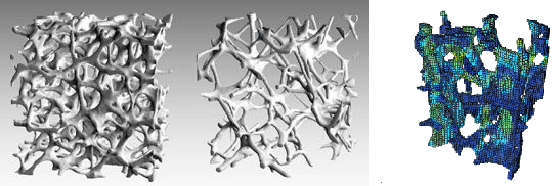
The background problem addressed within this project is osteoporosis (loss of bone mineral density and deterioration of bone micro-architecture). This is a disease, ranked by the World Health Organization as second most important health care problem nowadays.
Using micro computed tomography, we are able to reconstruct the microstructure of bone tissue and to obtain high resolution 3D images. The latter can be automatically transformed into a 3D geometry, discretized by the so-called micro-finite element technique. The resulting models are expressed in terms of algebraic systems of equations of huge sizes, which easily reach hundreds of millions of degrees of freedom. Solving those systems, one can simulate the behaviour of the bone tissue under certain static or dynamic loads and detect/predict osteoporosis-induced fractures.
As a far goal, the project aims to contribute by developing fast, efficient and reliable solution techniques to enabling a computer-aided environment, which could serve orthopedists and surgeons in prevention, management and post-medical surveillance of patients exposed to osteoporosis.
Due to the enormous problem sizes, the solution of the above task is highly nontrivial and requires both high performance computing facilities as well as efficient numerical solution techniques. First results and comparisons with existing techniques obtained at TDB can be found in [1]. The next step, a stusy of applying a dynamic load on the solution methods was finalized in May, 2009 ([2]).
The research is synscronized and conducted in collaboration with groups and experts from Eindhoven University of Technology, The Netherlands, The Institute for Parallel Processing, Bulgarian Academy of Sciences, The Institute of Computational Science, ETH Zürich, Switzerland, The Academic Hospital, Uppsala and others.
Project extentions: poroelasticity, multiscale models, contact problems, homogenization, parallel computations.
The developed solution techniques within this project are of general nature and could be successfully applied to problems arising in different application areas, such as Geophysics, namely, modelling of viscoelastic materials, modelling of glaciation/deglaciation cycles, including multiscale effects related to the contact area between glacier and Earth surface.
Publications:
[1] Shaman Mahmoudi, Large scale numerical simulations of bone structures.
Master of Science Thesis, Uppsala University, March 2007.
[2] Guanwen Ying, Efficient harmonic simulations of trabecular
bone micro finite element models. Master of Science Thesis,
Uppsala University, 2009.
[3] Maya Neytcheva,
Efficient preconditioning of elasticity problems from bone mechanics
simulations. Manuscript in progress.